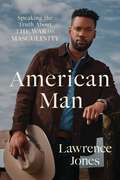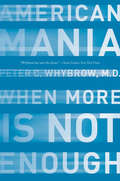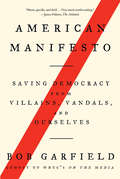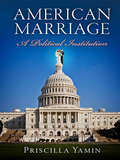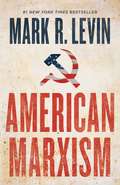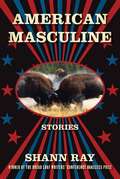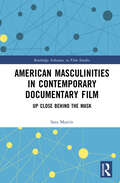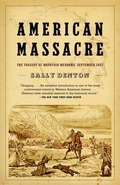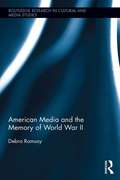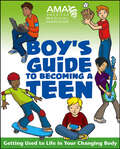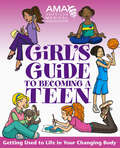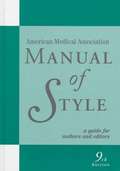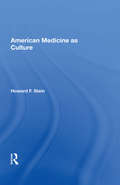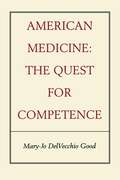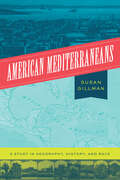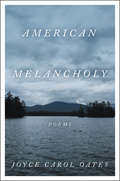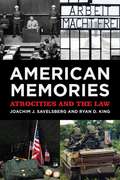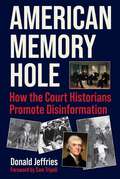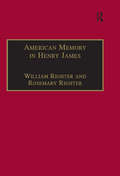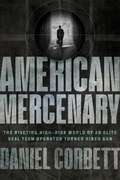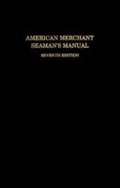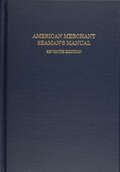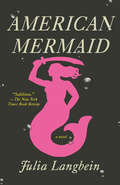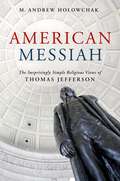- Table View
- List View
American Magnitude: Hemispheric Vision and Public Feeling in the United States
by Christa J. OlsonAt a moment in US politics when racially motivated nationalism, shifting relations with Latin America, and anxiety over national futures intertwine, understanding the long history of American preoccupation with magnitude and how it underpins national identity is vitally important. In American Magnitude, Christa J. Olson tracks the visual history of US appeals to grandeur, import, and consequence (megethos), focusing on images that use the wider Americas to establish US character. Her sources—including lithographs from the US-Mexican War, pre–Civil War paintings of the Andes, photo essays of Machu Picchu, and WWII-era films promoting hemispheric unity—span from 1845 to 1950 but resonate into the present. <p><p>Olson demonstrates how those crafting the appeals that feed the US national imaginary—artists, scientists, journalists, diplomats, and others—have invited US audiences to view Latin America as a foil for the greatness of their own nation and encouraged white US publics in particular to see themselves as especially American among Americans. She reveals how each instance of visual rhetoric relies upon the eyes of others to instantiate its magnitude—and falters as some viewers look askance instead. The result is the possibility of a post-magnitude United States: neither great nor failed, but modest, partial, and imperfect.
American Man: Speaking the Truth about the War on Masculinity
by Lawrence JonesFox & Friends cohost Lawrence Jones delivers the common sense book America needs more than ever in this definitive takedown of the left&’s never-ending attacks on masculinity. A generation ago it was understood that men and women were unique, yet interdependent, and designed by God to be that way. Today, the woke crowd wants you to believe masculinity is &“toxic.&” In his first book, Lawrence embarks on a thorough examination of who is doing the attacking and why. Informed by his travels across the country for Fox News, Lawrence explains how confused progressives are about manhood—and how powerful the need is to set the record straight. Men, he argues, are indispensable to thriving families and prosperous societies, and the sooner men start acting like men, the better off we all will be. Packed with stories from his own life and work, Lawrence makes a persuasive case for the virtues of manliness—courage, resilience, godliness, and self-reliance among others. Lawrence challenges his fellow men to live up to their responsibilities as men and to fill the cultural void woke ideologues have been happy to exploit. In confronting the chaos of contemporary culture, Lawrence is forced to reexamine his own beliefs as he spurs an honest discussion about what it means to be a man in America. The book also includes candid, never-before-shared interviews conducted by Lawrence of his Fox News colleagues, like Sean Hannity, Mark Levin, Pete Hegseth, Will Cain, as well as other prominent voices like NFL great Ben Watson and actor Dean Cain. This insightful and uncompromising book from one of the country&’s fastest rising stars will enlighten and inspire readers—as it proves once and for all the crucial role men can and must play in American life today.
American Mania: When More is Not Enough
by Peter C. WhybrowA doctor's bold analysis of the cultural disease that afflicts us all. Despite an astonishing appetite for life, more and more Americans are feeling overworked and dissatisfied. In the world's most affluent nation, epidemic rates of stress, anxiety, depression, obesity, and time urgency are now grudgingly accepted as part of everyday existence they signal the American Dream gone awry. Peter C. Whybrow, director of the Neuropsychiatric Institute at UCLA, grounds the extraordinary achievements and excessive consumption of the American nation in an understanding of the biology of the brain's reward system offering for the first time a comprehensive and physical explanation for the addictive mania of consumerism. American Mania presents a clear and novel vantage point from which to understand the most pressing social issues of our time, while offering an informed approach to refocusing our pursuit of happiness. Drawing upon rich scientific case studies and colorful portraits, "this fascinating and important book will change the way you think about American life" (Karen Olson, Utne Reader).
American Manifesto: Saving Democracy from Villains, Vandals, and Ourselves
by Bob GarfieldDo you fear for our democracy? Are you perplexed by Trumpism? Are you ready to throw in the towel? Don’t! This is your guidebook to reassembling our hyperpolarized American society in six (not–so–easy) steps, written by cohost of WNYC's On the Media Bob GarfieldAs is often observed, Trump is a symptom of a virus that has been incubating for at least fifty years. But not often observed is where the virus is imbedded: in the psychic core of our identity. In American Manifesto: Saving Democracy from Villains, Vandals, and Ourselves, popular media personality Bob Garfield examines the tragic confluence of the American preoccupation with identity and the catastrophic disintegration of the mass media. Garfield investigates how we’ve gotten to this moment when our identity is threatened by both the left and the right, when e pluribus unum is no longer a source of national pride, and why, when looking through this lens of identity, the rise of Trumpism is no surprise. Overlaying this crisis is the rise of the Facebook–Google duopoly and the filter bubble of social media, where identity is insular and immutable.But fear not! WNYC’s On the Media cohost Garfield has ideas about how we may counter the forces of fragmentation—the manifesto itself: six steps to take to reassemble our fractured society. A quick, fascinating read, American Manifesto offers not only a vision of a country in extremis, but also a plan for how to address the ways in which our democracy is imperiled. Provocative, profound, and sometimes hilariously profane, American Manifesto is a call to action like no other.
American Marriage
by Priscilla YaminAs states across the country battle internally over same-sex marriage in the courts, in legislatures, and at the ballot box, activists and scholars grapple with its implications for the status of gays and lesbians and for the institution of marriage itself. Yet, the struggle over same-sex marriage is only the most recent political and public debate over marriage in the United States. What is at stake for those who want to restrict marriage and for those who seek to extend it? Why has the issue become such a national debate? These questions can be answered only by viewing marriage as a political institution as well as a religious and cultural one.In its political dimension, marriage circumscribes both the meaning and the concrete terms of citizenship. Marriage represents communal duty, moral education, and social and civic status. Yet, at the same time, it represents individual choice, contract, liberty, and independence from the state. According to Priscilla Yamin, these opposing but interrelated sets of characteristics generate a tension between a politics of obligations on the one hand and a politics of rights on the other. To analyze this interplay, American Marriage examines the status of ex-slaves at the close of the Civil War, immigrants at the turn of the twentieth century, civil rights and women's rights in the 1960s, and welfare recipients and gays and lesbians in the contemporary period. Yamin argues that at moments when extant political and social hierarchies become unstable, political actors turn to marriage either to stave off or to promote political and social changes. Some marriages are pushed as obligatory and necessary for the good of society, while others are contested or presented as dangerous and harmful. Thus political struggles over race, gender, economic inequality, and sexuality have been articulated at key moments through the language of marital obligations and rights. Seen this way, marriage is not outside the political realm but interlocked with it in mutual evolution.
American Marxism
by Mark R. LevinThe six-time #1 New York Times bestselling author, Fox News star, and radio host Mark R. Levin explains how the dangers he warned against in the “timely yet timeless” (David Limbaugh, author of Jesus Is Risen) bestseller Liberty and Tyranny have come to pass. <P><P>In 2009, Mark R. Levin galvanized conservatives with his unforgettable manifesto Liberty and Tyranny, by providing a philosophical, historical, and practical framework for halting the liberal assault on Constitution-based values. That book was about standing at the precipice of progressivism’s threat to our freedom and now, over a decade later, we’re fully over that precipice and paying the price. <P><P>In American Marxism, Levin explains how the core elements of Marxist ideology are now pervasive in American society and culture—from our schools, the press, and corporations, to Hollywood, the Democratic Party, and the Biden presidency—and how it is often cloaked in deceptive labels like “progressivism,” “democratic socialism,” “social activism,” and more. With his characteristic trenchant analysis, Levin digs into the psychology and tactics of these movements, the widespread brainwashing of students, the anti-American purposes of Critical Race Theory and the Green New Deal, and the escalation of repression and censorship to silence opposing voices and enforce conformity. Levin exposes many of the institutions, intellectuals, scholars, and activists who are leading this revolution, and provides us with some answers and ideas on how to confront them. <P><P> As Levin writes: “The counter-revolution to the American Revolution is in full force. And it can no longer be dismissed or ignored for it is devouring our society and culture, swirling around our everyday lives, and ubiquitous in our politics, schools, media, and entertainment.” And, like before, Levin seeks to rally the American people to defend their liberty. <P><P><b>A New York Times Best Seller</b>
American Masculine: Stories
by Shann RayWinner of the 2010 Bakeless Prize for Fiction, a muscular debut that reconfigures the American WestThe American West has long been a place where myth and legend have flourished. Where men stood tall and lived rough. But that West is no more. In its place Shann Ray finds washedup basketball players, businessmen hiding addictions, and women fighting the inexplicable violence that wells up in these men. A son struggles to accept his father's apologies after surviving a childhood of beatings. Two men seek empty basketball hoops on a snowy night, hoping to relive past glory. A bull rider skips town and rides herd on an unruly mob of passengers as he searches for a thief on a train threading through Montana's Rocky Mountains. In these stories, Ray grapples with the terrible hurt we inflict on those we love, and finds that reconciliation, if far off, is at least possible. The debut of a writer who is out to redefine the contours of the American West, American Masculine is a deeply felt and fiercely written ode to the country we left behind.
American Masculinities in Contemporary Documentary Film: Up Close Behind the Mask (Routledge Advances in Film Studies)
by Sara MartínMost documentaries deal with men, but what do they actually say about masculinity? In this groundbreaking volume Sara Martín analyses more than forty 21st-century documentaries to explore how they represent American men and masculinity. From Jennifer Siebel Newsom’s The Mask You Live In to Raoul Peck’s I Am Not Your Negro, this volume explores sixteen different faces of American masculinity: the good man, the activist, the politician, the whistleblower, the criminal, the sexual abuser, the wrongly accused, the dependent man, the soldier, the capitalist, the adventurer, the sportsman, the architect, the photographer, the musician, and the writer. The collective portrait drawn by the documentaries discloses a firm critical stance against the contradictions inherent in patriarchy, which makes American men promises of empowerment it cannot fulfill. The filmmakers’ view of American masculinity emphasizes the vulnerability of disempowered men before the abuses of the patriarchal system run by hegemonic men and a loss of bearings about how to be a man after the impact of feminism, accompanied nonetheless by a celebration of resilient masculinity and of the good American man. Firmly positioning documentaries as an immensely flexible, relevant tool to understand 21st-century American men and masculinity, their past, present, and future, this book will interest students and scholars of film studies, documentary film, American cultural studies, gender, and masculinity.
American Massacre: The Tragedy At Mountain Meadows, September 1857
by Sally DentonControversy has raged over identity of the organizers and participants of the "Mountain Meadows Massacre" ever since a California-bound wagon train was beset in Utah Territory in 1857 by local Mormons and Paiute Indians (as the story is conventionally told--Paiutes contest this version and are now supported by physical evidence), killing all but seven of the 140 emigrants over the course of four days. The only person ever held criminally responsible for the crime, John D. Lee, was executed 20 years later, condemning the Mormon Church Leaders as the real instigators of the crime. Investigative reporter Denton revisits those events, exploring the development and aftermath of the episode, concluding that Brigham Young and other church leaders were indeed responsible. Annotation (c)2003 Book News, Inc., Portland, OR (booknews.com)
American Media and the Memory of World War II (Routledge Research in Cultural and Media Studies)
by Debra RamsayFor three generations of Americans, World War II has been a touchstone for the understanding of conflict and of America’s role in global affairs. But if World War II helped shape the perception of war for Americans, American media in turn shape the understanding and memory of World War II. Concentrating on key popular films, television series, and digital games from the last two decades, this book explores the critical influence World War II continues to exert on a generation of Americans born over thirty years after the conflict ended. It explains how the war was configured in the media of the wartime generation and how it came to be repurposed by their progeny, the Baby Boomers. In doing so, it identifies the framework underpinning the mediation of World War II memory in the current generation’s media and develops a model that provides insight into the strategies of representation that shape the American perspective of war in general.
American Medical Association Boy's Guide to Becoming a Teen: Getting Used to Life in Your Changing Body
by American Medical AssociationA boy&’s &“straightforward, accessible, and nonjudgmental&” guide to everything they need to know about puberty and becoming a teen (Booklist). Becoming a teen is an important milestone in every boy&’s life. It&’s especially important at this time to get answers and advice from a trusted source. The American Medical Association Boy&’s Guide to Becoming a Teen is filled with invaluable advice to get you ready for the changes you will experience during puberty. Learn about these important topics and more: · Puberty and what kinds of physical and emotional changes you can expect—from your developing body to your feelings about girls · The importance of eating the right foods and taking care of your body · Pimples, acne, and how to properly care for your skin · Your reproductive system—inside and out · Thinking about relationships and dealing with new feelings The American Medical Association Boy&’s Guide to Becoming a Teen will help you understand the health issues that are of most concern to teenage boys, and will teach you how to be safe, happy, and healthy through these years.
American Medical Association Girl's Guide to Becoming a Teen: Getting Used to Life in Your Changing Body
by American Medical AssociationA girl&’s straightforward, accessible, and nonjudgmental guide to everything they need to know about adolescence and growing up. Becoming a teen is an important milestone in every girl&’s life. It&’s especially important at this time to get answers and advice from a trusted source. The American Medical Association Girl&’s Guide to Becoming a Teen is filled with invaluable advice to get you ready for the changes you will experience during puberty. Learn about these important topics and more: · Puberty and what kinds of physical and emotional changes you can expect—from your developing body to your feelings about boys · The importance of eating the right foods and taking care of your body · Your reproductive system inside and out · Starting your period—what it means and how to handle it · Thinking about relationships and dealing with new feelings The American Medical Association Girl&’s Guide to Becoming a Teen will help you understand the health issues that are of most concern to teenage girls, and will teach you how to be safe, happy, and healthy through these years. &“Girls covers the physical and emotional changes that puberty brings, along with solid tips about grooming, diet, exercise, and other health issues, such as eating disorders. . . . Girls will find plenty of useful information.&” —Booklist
American Medical Association Manual of Style: A Guide for Authors and Editors (9th edition)
by Cheryl IversonThe latest edition features an expanded chapter on legal and ethical concerns in publishing. Readers will also find an extensive chapter on statistics, a completely updated chapter on nomenclature, new policies for eponyms and numbers styles, a larger references section, an expanded discussion of inclusive language and abbreviations, and a larger section on figures and tables. A new section on typography is also featured, along with current information on electronic publishing, encompassing rapid changes affecting the publishing environment. End-of-chapter references make the book easier to use, and the entire text is reviewed by more than 70 editors for accuracy and dependability.
American Medicine As Culture
by Howard F. SteinThis book situates biomedicine within American culture and argues that the very organization and practice of medicine are themselves cultural. It demonstrates the symbolic construction of clinical reality within American biomedicine and shows how biomedicine never leaves the realm of the personal.
American Medicine: The Quest for Competence
by Mary-Jo DelVecchio GoodWhat does it mean to be a good doctor in America today? How do such challenges as new biotechnologies, the threat of malpractice suits, and proposed health-care reform affect physicians' ability to provide quality care?These and many other crucial questions are examined in this book, the first to fully explore the meaning and politics of competence in modern American medicine. Based on Mary-Jo DelVecchio Good's recent ethnographic studies of three distinct medical communities—physicians in rural California, academics and students involved in Harvard Medical School's innovative "New Pathway" curriculum, and oncologists working on breast cancer treatment—the book demonstrates the centrality of the issue of competence throughout the medical world. Competence, it shows, provides the framework for discussing the power struggles between rural general practitioners and specialists, organizational changes in medical education, and the clinical narratives of high-technology oncologists. In their own words, practitioners, students, and academics describe what competence means to them and reveal their frustration with medical-legal institutions, malpractice, and the limitations of peer review and medical training.Timely and provocative, this study is essential reading for medical professionals, academics, anthropologists, and sociologists, as well as health-care policymakers.
American Mediterraneans: A Study in Geography, History, and Race
by Susan GillmanThe story of the “American Mediterranean,” both an idea and a shorthand popularized by geographers, historians, novelists, and travel writers from the early nineteenth century to the 1970s. The naturalist Alexander von Humboldt, visiting the Gulf-Caribbean in the early nineteenth century, called it America’s Mediterranean. Almost a century later, Southern California was hailed as “Our Mediterranean, Our Italy!” Although “American Mediterranean” is not a household phrase in the United States today, it once circulated widely in French, Spanish, and English as a term of art and folk idiom. In this book, Susan Gillman asks what cultural work is done by this kind of unsystematic, open-ended comparative thinking.American Mediterraneans tracks two centuries of this geohistorical concept, from Humboldt in the early 1800s, to writers of the 1890s reflecting on the Pacific world of the California coast, to writers of the 1930s and 40s speculating on the political past and future of the Caribbean. Following the term through its travels across disciplines and borders, American Mediterraneans reveals a little-known racialized history, one that paradoxically appealed to a range of race-neutral ideas and ideals.
American Melancholy: Poems
by Joyce Carol OatesA new collection of poetry from an American literary legend, her first in twenty-five yearsJoyce Carol Oates is one of our most insightful observers of the human heart and mind, and, with her acute social consciousness, one of the most insistent and inspired witnesses of a shared American history. Oates is perhaps best known for her prodigious output of novels and short stories, many of which have become contemporary classics. However, Oates has also always been a faithful writer of poetry. American Melancholy showcases some of her finest work of the last few decades. Covering subjects big and small, and written in an immediate and engaging style, this collection touches on both the personal and political. Loss, love, and memory are investigated, along with the upheavals of our modern age, the reality of our current predicaments, and the ravages of poverty, racism, and social unrest. Oates skillfully writes characters ranging from a former doctor at a Chinese People’s Liberation Army hospital to Little Albert, a six-month-old infant who took part in a famous study that revealed evidence of classical conditioning in human beings.
American Memories: Atrocities and the Law
by Ryan D. King Joachim J. SavelsbergIn the long history of warfare and cultural and ethnic violence, the twentieth century was exceptional for producing institutions charged with seeking accountability or redress for violent offenses and human rights abuses across the globe, often forcing nations to confront the consequences of past atrocities. The Holocaust ended with trials at Nuremberg, apartheid in South Africa concluded with the Truth and Reconciliation Commission, and the Gacaca courts continue to strive for closure in the wake of the Rwandan genocide. Despite this global trend toward accountability, American collective memory appears distinct in that it tends to glorify the nation’s past, celebrating triumphs while eliding darker episodes in its history. In American Memories, sociologists Joachim Savelsberg and Ryan King rigorously examine how the United States remembers its own and others’ atrocities and how institutional responses to such crimes, including trials and tribunals, may help shape memories and perhaps impede future violence. American Memories uses historical and media accounts, court records, and survey research to examine a number of atrocities from the nation’s past, including the massacres of civilians by U.S. military in My Lai, Vietnam, and Haditha, Iraq. The book shows that when states initiate responses to such violence—via criminal trials, tribunals, or reconciliation hearings—they lay important groundwork for how such atrocities are viewed in the future. Trials can serve to delegitimize violence—even by a nation’s military— by creating a public record of grave offenses. But the law is filtered by and must also compete with other institutions, such as the media and historical texts, in shaping American memory. Savelsberg and King show, for example, how the My Lai slayings of women, children, and elderly men by U.S. soldiers have been largely eliminated from or misrepresented in American textbooks, and the army’s reputation survived the episode untarnished. The American media nevertheless evoked the killings at My Lai in response to the murder of twenty-four civilian Iraqis in Haditha, during the war in Iraq. Since only one conviction was obtained for the My Lai massacre, and convictions for the killings in Haditha seem increasingly unlikely, Savelsberg and King argue that Haditha in the near past is now bound inextricably to My Lai in the distant past. With virtually no criminal convictions, and none of higher ranks for either massacre, both events will continue to be misrepresented in American memory. In contrast, the book examines American representations of atrocities committed by foreign powers during the Balkan wars, which entailed the prosecution of ranking military and political leaders. The authors analyze news accounts of the war’s events and show how articles based on diplomatic sources initially cast Serbian President Slobodan Milosevic in a less negative light, but court-based accounts increasingly portrayed Milosevic as a criminal, solidifying his image for the public record. American Memories provocatively suggests that a nation’s memories don’t just develop as a rejoinder to events—they are largely shaped by institutions. In the wake of atrocities, how a state responds has an enduring effect and provides a moral framework for whether and how we remember violent transgressions. Savelsberg and King deftly show that such responses can be instructive for how to deal with large-scale violence in the future, and hopefully how to deter it. A Volume in the American Sociological Association’s Rose Series in Sociology.
American Memory Hole: How the Court Historians Promote Disinformation
by Donald JeffriesDonald Jeffries takes another deep dive down the historical rabbit holes with American Memory Hole: How the Court Historians Promote Disinformation. You will discover how cancel culture was born during the administration of Franklin D. Roosevelt. And how our interventionist foreign policy was established during the Woodrow Wilson presidency. Jeffries documents the tragically common atrocities committed by US troops, beginning with the Mexican-American War, which became official policy under the &“total war&” and &“scorched earth&” strategy of Abraham Lincoln&’s bloodthirsty generals. He recounts the shocking abuses of our military forces, in countries like Mexico, Haiti, the Philippines, and elsewhere. Jeffries builds on his groundbreaking investigation into the murder of John F. Kennedy, Jr., uncovering even more evidence of conspiracy and cover-up. He talked to people no researcher has talked to before, in a powerful new section on the assassination of President John F. Kennedy. Jeffries explores the Kennedy family in general, and finds that the establishment, especially the Left, continues to treat them unfairly. The events of September 11, 2001, and the Oklahoma City Bombing are investigated in depth as never before. There is stunning new information on much maligned Senator Joseph McCarthy, who emerges here not as some irredeemable monster, but as a genuine American patriot who has been demeaned in death even more than he was in life. The reader will never look at the supposed heroes and villains of American history the same way again after reading this book. History is written by the victors.
American Memory in Henry James: Void and Value
by William RighterAmerican Memory in Henry James is about the cultural, historical and moral dislocations at the heart of Henry James' explorations of American identity - between power and love; modernity and history; indeterminate social forms and enduring personal values. The text covers the power, and the limits, of the language of morality and interpretive imagination as James grapples with what America and Europe have in common; and also with what, because their contexts and sense of history are so profoundly different, they cannot have in common. Righter's great theme is the tensions that impelled James ultimately to stretch the novel, his beloved 'prodigious form', almost to breaking point, in search of an ultimately elusive synthesis. The American Scene - his account of an America, revisited after long absence, that was reinventing itself right down to the touchstones of its identity - is its entry point; The Golden Bowl is its primary testing ground. The questions raised transcend the historical moment and the specifically Jamesian sense of dislocation, to go to the heart of modern identity, and the nature of literary endeavour.
American Mercenary: The Riveting, High-Risk World of an Elite SEAL Team Operator Turned Hired Gun
by Daniel CorbettAn elite Navy SEAL Team 6 operator trained to kill the United States&’ most dangerous enemies takes readers inside the unadulterated, morally complicated and riveting post-military adventures of a lethal American mercenary. In American Mercenary, Daniel Corbett takes readers on a wild ride through the unadulterated, morally ambiguous, and riveting world of being a hired gun. From Abu Dhabi to Washington, DC, Cairo to San Diego, Belgrade to places that must remain secret, this is a world where money rules, and where adventure, danger, and absurdity often follow. A star high school athlete, Corbett passed on a Division I football career and opted for the US Navy. He began his career at SEAL Team 5 and eventually checked into SEAL Team 6. The navy spent millions teaching him and his fellow Team members how to sneak, subvert, recruit, disappear, survive, resist, and exert. And of course, how to shoot, a discipline at which Corbett excelled. What the navy did not do was prepare these men for post-military lives beyond the usual suite of veterans&’ benefits and unimaginative job-training programs. So what does Corbett do? He goes private. There are still plenty of bad men in the world, and the only sin worse than wasting talent in dead-end pursuits is not using it at all. He starts small, but quickly moves up. The work is simultaneously familiar and foreign. The command structure is shady. The clients are dubious. The equipment is subpar. But what the fuck: the pay is good. Then things change in 2017 when Corbett is arrested on a job in Belgrade, Serbia. When the authorities discover he&’s a Navy SEAL, they imagine the worst: he&’s in Belgrade to assassinate the Serbian president. They throw Corbett in jail, where he spends the next 18 months making international headlines and fighting for his freedom in a kangaroo court. Ultimately, American Mercenary highlights the struggle of many veterans: how to reconcile military service with civilian life. For Corbett, becoming a mercenary isn&’t just the best option, it feels like the only option. It&’s a lot better than drowning in a bottle or holding a pistol under your chin and pulling the trigger, but is it enough?
American Merchant Seaman's Manual
by William B. Hayler John M. KeeverThe Merchant Marine is composed of all the commercial ships of a country and the personnel that man them. The American Merchant Seaman's Manual has been the primary seamanship text and reference book for the American Merchant Marine for more than sixty years. Merchant mariners going to sea for the first time need to know as much about their new job, their ship, the sea, and the Merchant Marine as they can. This manual is designed to provide the knowledge that these new seamen need to embark upon their careers at sea. Since the sixth edition was published in 1981, many changes have been made in each new printing. Changes in this new edition include a new chapter on Standards of Training, Certification and Watchkeeping for Seafarers, data on merchant fleets throughout the world, a revised chapter on wire rope, and a bibliography for sources of additional reading.
American Merchant Seaman's Manual
by William B. HaylerThe Merchant Marine is composed of all the commercial ships of a country and the personnel that man them. The American Merchant Seaman's Manual has been the primary seamanship text and reference book for the American Merchant Marine for more than sixty years. Merchant mariners going to sea for the first time need to know as much about their new job, their ship, the sea, and the Merchant Marine as they can. This manual is designed to provide the knowledge that these new seamen need to embark upon their careers at sea. Since the sixth edition was published in 1981, many changes have been made in each new printing. Changes in this new edition include: - A new chapter on Standards of Training, Certification and Watchkeeping for Seafarers - Data on merchant fleets throughout the world - A revised chapter on wire rope - A bibliography for sources of additional reading
American Mermaid: A Novel
by Julia LangbeinA MOST ANTICIPATED BOOK OF THE YEAR • "Sublime." —New York Times Book Review"Brilliantly sharp, funny, and thought-provoking, the gripping story of a woman trying to find her way in our chaotic world." —Madeline Miller, bestselling author of CirceBroke English teacher Penelope Schleeman is as surprised as anyone when her feminist, eco-warrior novel American Mermaid becomes a best-seller. But when Hollywood insists she convert her fierce, androgynous protagonist into to a teen sex object in a clamshell bra, strange things start to happen. Is Penelope losing her mind, or has her fictional mermaid come to life, enacting revenge against society&’s limited view of what a woman can and should be? American Mermaid follows a young woman braving the casual slights and cruel calculations of a winner-take-all society and discovering a beating heart in her own fiction: a new kind of hero who fights to keep her voice and choose her place. A hilarious story about deep things, American Mermaid asks how far we&’ll go to protect the parts of ourselves that are not for sale.
American Messiah: The Surprisingly Simple Religious Views of Thomas Jefferson
by M. Andrew HolowchakUncover the truth of Jefferson’s widely mistaken religious views.Many have written about Thomas Jefferson’s religious views, especially given his views on freedom of religion. Yet with so much written, scholars have not come close to a historical consensus on his religious motivations, leaving literature on Jefferson in disarray. Conversely, American Messiah traces Jefferson’s views of God from his beliefs in early life to his later commitments to Unitarianism, explicating Jefferson’s observations on religion and the impact they had on his overall understanding of faith.In American Messiah, Holowchak delivers a cohesive account of Jefferson’s perception of religion, including these aspects of Jefferson’s surprisingly simple religious beliefs:• True religion, for Jefferson, was equivalent to the axial principles of morality, concerning our duties to God and to man.• Jefferson did not believe in an afterlife late in life, and likely never believed in it.• Jefferson’s commitment to Unitarianism was not a commitment to a particular religious sect, but merely a commitment to a meta- or naturalized religion—the principles of the moral sense.• Freedom of religion, for Jefferson, was not driven by respect for the various religious sects, but by disdain for the baneful consequences of the sham and artificial metaphysical squabbles of religious sectarianism.

